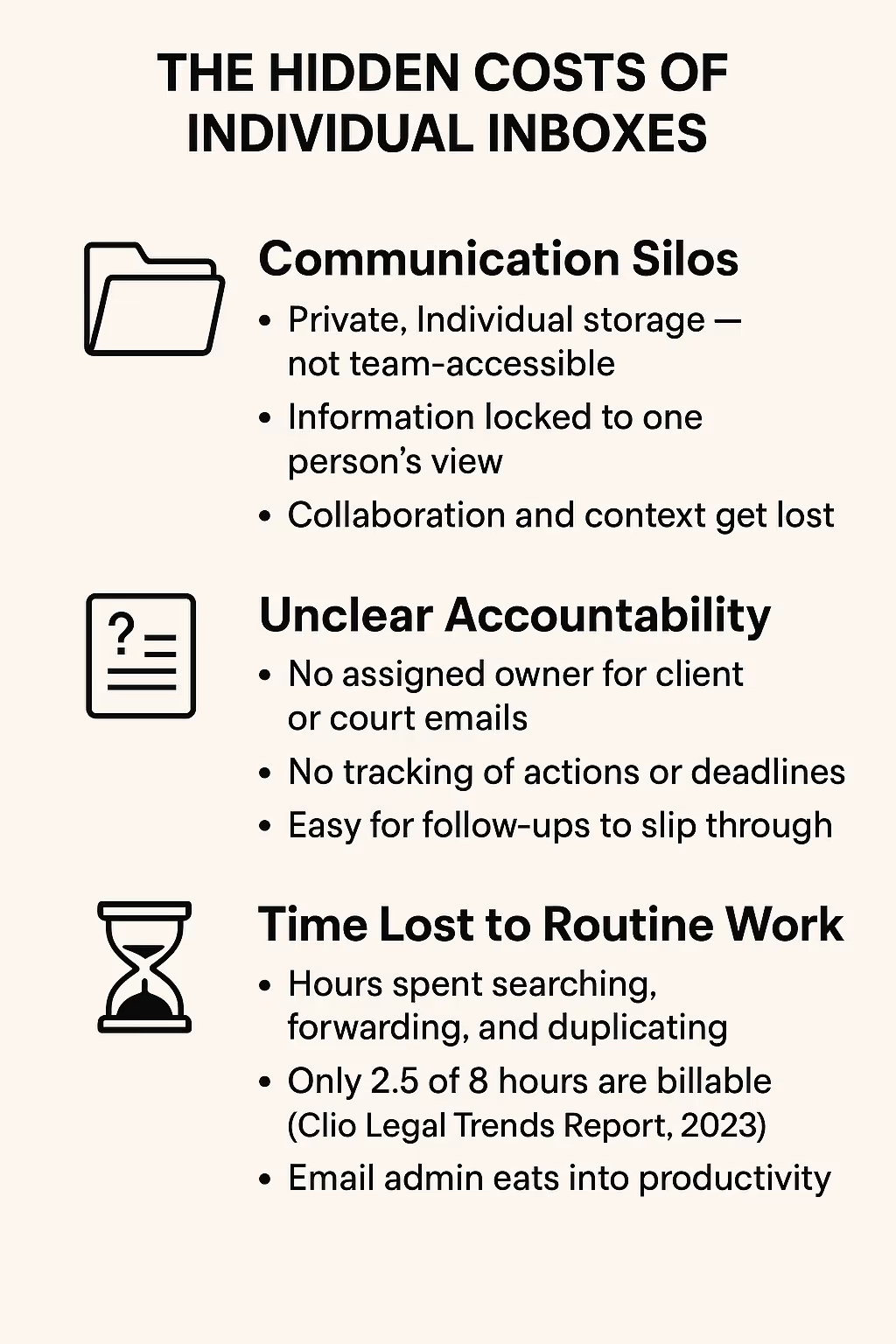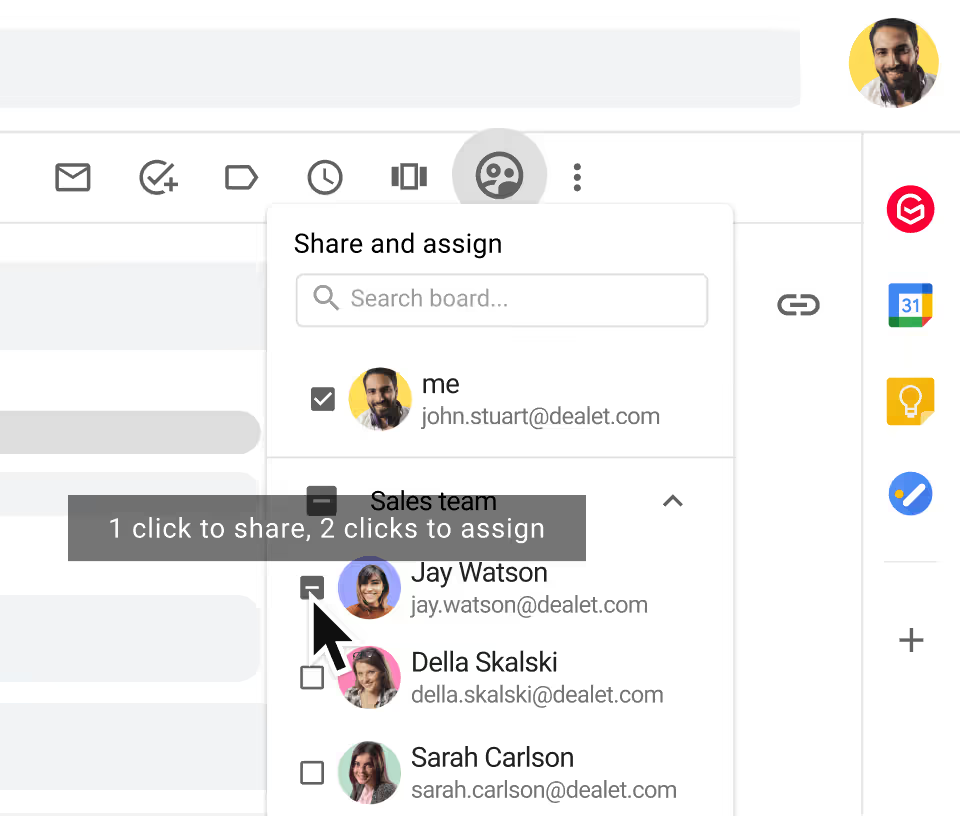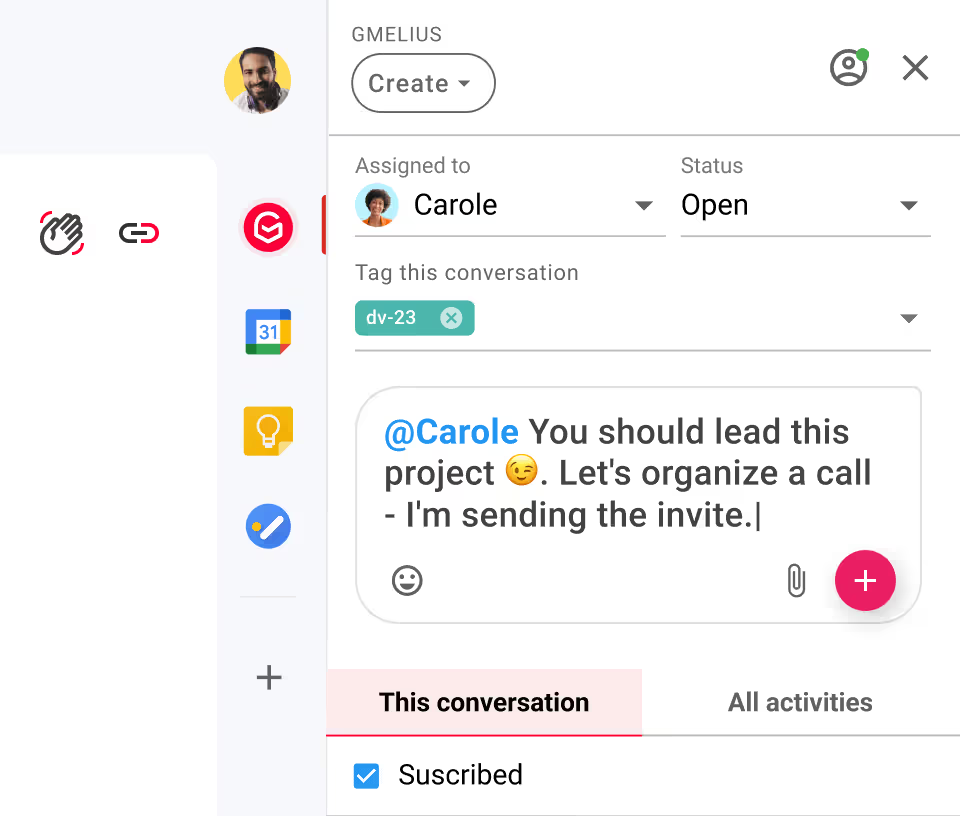Every law firm knows the feeling: a crucial piece of information is locked in one person's inbox, a client is waiting for a response, and nobody is quite sure who owns the request. The traditional email system, built for one-to-one messaging, is buckling under the pressure of modern legal collaboration.
This is where shared inboxes and AI-driven workflows come in. By centralizing communication, your team can eliminate the guesswork and create a single source of truth for every matter. This article explores the specific collaboration challenges legal teams face and provides a clear path forward with modern, intelligent tools.
Why Do Legal Teams Struggle With Email Collaboration?
The challenges legal teams face with email are not unique, but the consequences are far more severe. The fast-paced, high-stakes nature of legal work amplifies the inherent flaws of traditional email, leading to significant friction and risk.
Rising email volume is overwhelming
The modern legal professional is inundated. Emails pour in from clients seeking updates, partners assigning tasks, courts issuing notices, and opposing counsel filing motions.
According to a report by the McKinsey Global Institute, the average professional spends a staggering 28% of their workweek managing email.
For lawyers, who juggle multiple complex cases simultaneously, this number can feel even higher. Each case has its own ecosystem of communication, and when it all floods into a single, personal work inbox, it becomes nearly impossible to prioritize effectively.
Forwarding and cc’ing creates confusion
The classic "FW:" and the endless "CC:" chain are hallmarks of a broken workflow. Consider a simple client query about a discovery request.
The associate receives it and forwards it to a paralegal for the initial draft, CC'ing the senior partner for visibility. The paralegal replies-all with a question, the partner chimes in with a separate suggestion, and suddenly there are multiple forks in the conversation. This chaotic process creates several problems.
Version control becomes a nightmare, with attachments and key details scattered across different threads and inboxes. More importantly, accountability becomes dangerously ambiguous.
When multiple people are CC'd, the responsibility is diffused. Everyone assumes someone else is handling the final response, leading to the dreaded outcome where no one does. This "bystander effect" in email can lead to delayed client responses and damaged relationships.
Lack of visibility leads to delays
When all case-related communication is locked away in individual inboxes, the firm has zero operational visibility. A partner has no easy way to check the status of a client request without interrupting the associate handling it. If that associate is in court, in a deposition, or out sick, that communication is effectively in a black hole.
This lack of transparency means there is no single source of truth for a legal matter. Team members waste precious time hunting down information by searching their own archives or asking colleagues, "Did you see that email from Client X?"
Why Traditional Email Falls Short for Legal Collaboration
The struggles detailed above are not just user problems; they are symptoms of a tool that was designed for one-to-one communication being forced to handle complex, many-to-many team collaboration. Here’s why the traditional inbox model is fundamentally unsuited for the demands of a modern legal team.

Individual inboxes creating silos
An individual inbox is, by design, a silo. It functions as a private digital filing cabinet, accessible only to its owner. This model is the antithesis of the collaborative nature of legal work, where paralegals, associates, and partners must work in concert. When client communications are siloed, the team loses its collective intelligence.
No clear accountability for client or court emails
A standard email in a personal inbox has no inherent owner. It is simply a message that has arrived. While the recipient is implicitly responsible, there is no formal mechanism to assign ownership or track the status of the required action. This is a critical flaw in a legal setting.
Time wasted searching, forwarding, and duplicating work
The inefficiency of the traditional inbox has a direct impact on a law firm's bottom line. The 2023 Clio Legal Trends Report found that, on average, lawyers spend only 2.5 hours of an 8-hour day on billable work. The rest of the time is consumed by administrative tasks, a significant portion of which is email management.
How Shared Inboxes and AI Help Legal Teams Collaborate More Effectively
A shared inbox is not just a group email address; it's a collaborative platform built inside your existing email client that transforms a chaotic influx of messages into an organized, accountable workflow.
By centralizing communication and providing tools for seamless teamwork, platforms like Gmelius directly address the shortcomings of traditional email.
Centralizing all client and matter communication
Instead of emails going to individual lawyers, they can be directed to dedicated shared inboxes like clients@yourfirm.com or matter-1234@yourfirm.com. This creates a single, transparent repository for all communication related to a client or case.
Everyone on the team has access to the same information in real-time, eliminating silos and providing a complete, chronological record of every interaction. This ensures a unified understanding of the case and allows any team member to get up to speed instantly.
Assigning emails directly instead of forwarding
With a shared inbox, confusion over responsibility is eliminated. When an email arrives, it can be instantly assigned to a specific team member with a single click. This email assignment feature makes ownership crystal clear.

The assigned individual is now accountable for seeing the task through to completion. The entire team can see who is responsible for what, preventing both duplicate work and the risk of an important email going unanswered. The status of the email (e.g., Open, Pending, Closed) provides at-a-glance visibility into the team's workload and progress.
Using shared AI tags to keep threads organized effortlessly
Manually filing every email into the correct folder is tedious and prone to human error. This is where AI becomes a game-changer. With tools like Gmelius AI assistants, your inbox can learn to automatically categorize and tag incoming emails.

You can set up rules to tag messages with the relevant matter number, client name, document type, or urgency level. These shared labels are visible to the entire team, creating a consistently organized system that requires minimal manual effort.
Imagine every email related to the "Smith v. Jones" case being automatically tagged and sorted the moment it arrives — no more manual filing, no more lost messages.
Maintaining a clear audit trail for compliance and accountability
In the legal world, a verifiable record is paramount. Shared inbox platforms provide a detailed and immutable audit trail for every email. The activity log shows precisely who opened a message, who assigned it, when it was closed, and any internal notes that were made.
This comprehensive history is invaluable for internal audits, resolving client disputes, and demonstrating due diligence for compliance and malpractice insurance purposes.
Enabling internal notes and real-time collaboration on threads
Instead of creating convoluted forward chains to discuss a client email, teams can collaborate directly within the email thread itself using email notes. These notes are like a private chat, visible only to your team, that lives right alongside the client's message.

You can @mention colleagues to ask questions, share drafts, and formulate a strategy without ever leaving your inbox or cluttering the client's view. This keeps the external communication clean and professional while allowing for robust internal discussion and decision-making.
Allowing seamless coverage when lawyers are out of office
When a key attorney is on vacation or unexpectedly out of the office, their cases don't stop. With a shared inbox, their workload doesn't come to a grinding halt. The rest of the team can see all incoming emails for their matters and step in to handle urgent requests without delay.
There is no need to guess the lawyer's password or forward their entire inbox. This ensures seamless continuity of service, keeps cases moving forward, and provides clients with the uninterrupted support they expect.
Next Steps: What to Look for in a Shared Inbox for Legal Teams
Adopting a shared inbox is a strategic move to future-proof your firm’s communication and collaboration.
As you evaluate potential solutions, try and find a platform that meets the specific security, compliance, and workflow needs of the legal industry. Here are the key features to look for:
- Seamless integration: The tool should work within your existing email client (e.g.,Gmail/Google Workspace).
- Granular access control: You need the ability to control which team members can access which inboxes and what actions they can perform.
- Robust automation and AI: Look for intelligent features that go beyond simple sharing, like automated rules, AI-powered tagging, and email templates.
- Clear accountability tools: The platform must include clear email assignment, status tracking, and activity logs to ensure every single email is owned.
- Built-in collaboration features: The ability to add internal notes and see when a teammate is viewing or replying to an email (collision detection) is vital for preventing crossed wires.
- Security and compliance: Ensure the provider meets high-security standards and can support your firm's compliance requirements regarding data privacy and client confidentiality.
Legal work is too important to be hindered by outdated tools. With Gmelius, you can turn Gmail into a secure, shared workspace while enhancing productivity, reducing risk, and delivering faster client service.



.avif)
.avif)

![Transforme várias contas do Gmail em uma caixa de entrada [Guia de 2025]](https://cdn.prod.website-files.com/6737568a4ac417efeb387e5a/67d2fabec0cc2aab9168ba04_67cb05c9f7bc492cfb0e7734_Unity%2520in%2520Diversity%2520-%2520Hands%2520of%2520So%2520(1).avif)

